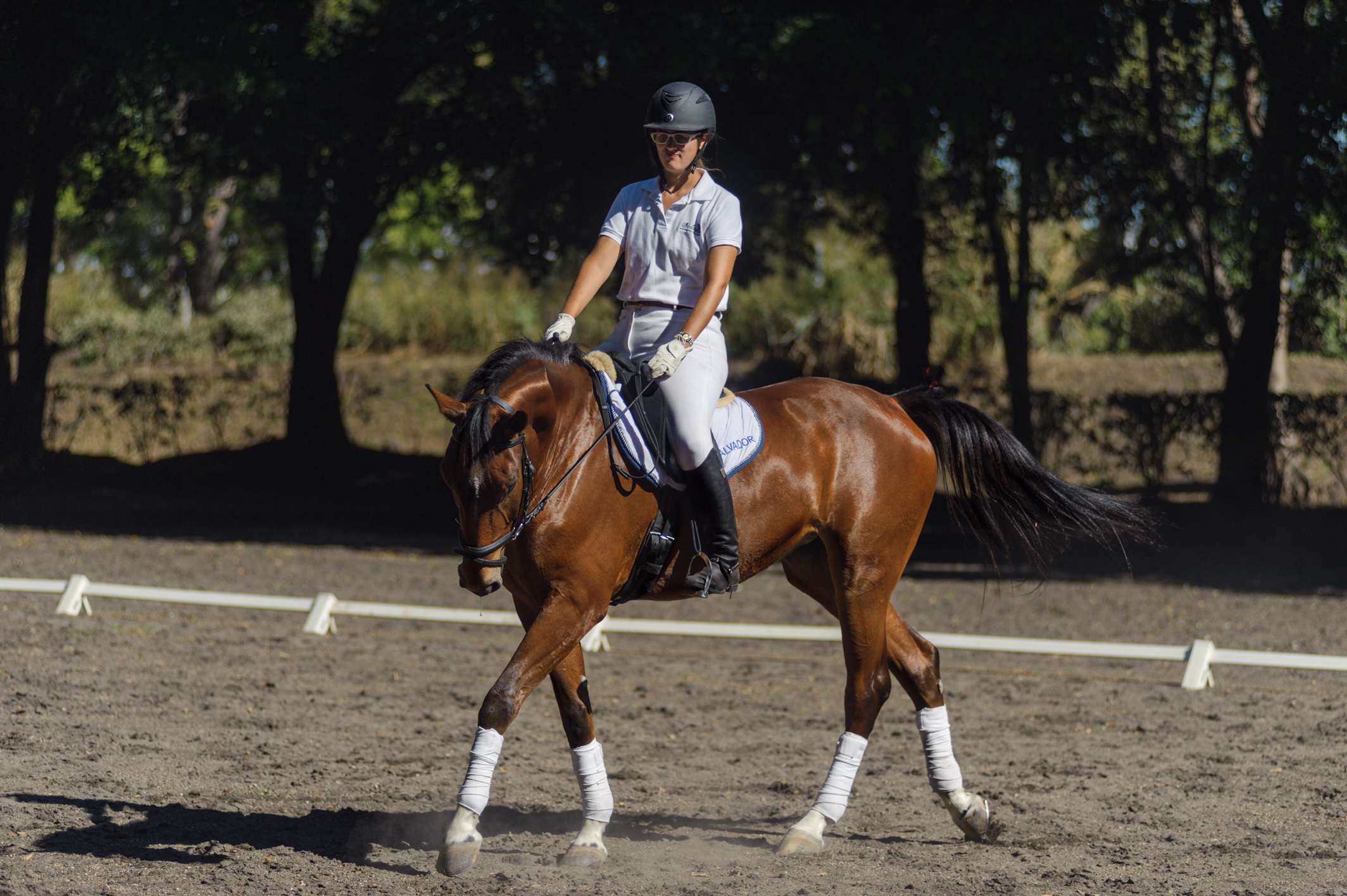
In this picture Andrea Francés is riding her 4-year-old mare, Stella. Andrea lives in El Salvador, an area that she mentioned does not have many horses, but she luckily found this locally bred mare with Belgian bloodlines, whom she purchased as a youngster. Andrea started her a year ago by herself and wrote that she does have some trouble balancing her in the canter. Even though the picture is taken from an angle that makes it difficult to judge the horse, I do get the impression that Stella has nice conformation. She looks to be an elegant young horse with a harmonious appearance. She might be a bit long in the back, but this can be dealt with in training.
In the picture I can see that Stella is not yet stepping forward enough under the rider’s weight with her inside hind leg. This is often connected to the activity in the horse’s back. To be able to step more under the rider’s weight, the horse needs to lift her shoulders and back more.
Andrea says that when Stella gets tired, especially after the canter, she pulls her head up a lot. To me, this shows a balance reaction to a weakness in the back. In canter, a horse needs to move her back more and in a different way than she does in trot. When all four feet are off the ground during the canter jump (or moment of suspension), the horse’s back is round like a ball. When she is in the landing phase of the stride, the horse needs to hollow her back while her legs cover the ground. A young horse is not yet able to collect and, naturally, the canter strides of a young horse are longer, which requires even bigger movement in the back. Carrying the weight of a rider is then more difficult.
I can see that Andrea is sitting upright, trying to help Stella bring more weight toward the hind legs, while attempting to give with her hands for Stella’s neck to reach out. My impression is that Stella is not yet strong and balanced enough to lift her back with the weight.
During this time that Stella continues to build strength, I would tell Andrea to work in a more forward position. When taking the forward position, she should try not to put too much weight into the stirrups. Since they are attached to the tree of the saddle, pushing weight into the stirrups logically puts more weight on the front section of the horse’s back. In the correct forward position, the rider’s weight shifts along the thighbone toward the knee and calf muscle. It is a bit like giving the horse a nice hug with the legs without squeezing. With more weight on the sides and the security of this “hugging” leg position, the horse should be able to swing upward with her back much more easily.
Andrea should feel that her own center of gravity in this forward position is deeper and closer to the horse’s center of gravity. Connecting these centers and then slowly riding transitions between the forward position and the dressage position can be a very helpful exercise for both of them. Becoming aware and finding where the horse feels the rider’s weight is an important step to using your weight aids correctly. Lowering your center of gravity while widening your balance base can also help give you more stability as you play with your weight aids. Try this: Stand on the ground a bit like a sumo wrestler. You’ll find that this position is more secure than standing with your feet together and on your toes like a ballet dancer. Children who are learning to walk move a bit like little sumo wrestlers even if they later become ballerinas! In riding, whenever there is a balance problem, lowering the center of gravity and widening the base is a good tool to reestablish security. I am positive that Andrea can address the issue of Stella pulling her head up by improving her stability and balance.
Try this: Even in walk and trot, Andrea can practice taking a forward position. Then as she sits deeper, she can feel how her own weight slowly slides up her thigh toward her seat bones, so that she can feel Stella carrying her more on her ribs and more on top of her back. Like massaging hands, Andrea’s weight can “caress” the horse from the sides up to the center of the back and to the sides again. This encourages Stella to lift her back, freeing the way for the hind leg to swing forward under her center of gravity. Feeling where the horse can carry her best will help Andrea establish the best balance. The eventual aim, of course, is that both horse and rider become more like ballet dancers, but this has to be built up slowly to avoid tension and stress on joints and muscles.
If a horse keeps lifting up her head in the canter transition, it can be helpful to ride these transitions in the forward position. Often it solves the problem as it frees the horse’s back to round and engages the hind end.
Riding many transitions between trot and canter helps to establish a better balance in the canter, too.
I hope these ideas will help Andrea develop this nice and sympathetic mare. As I live in Israel, I certainly know about the difficulties of training horses in a not-so-
horsey environment.











